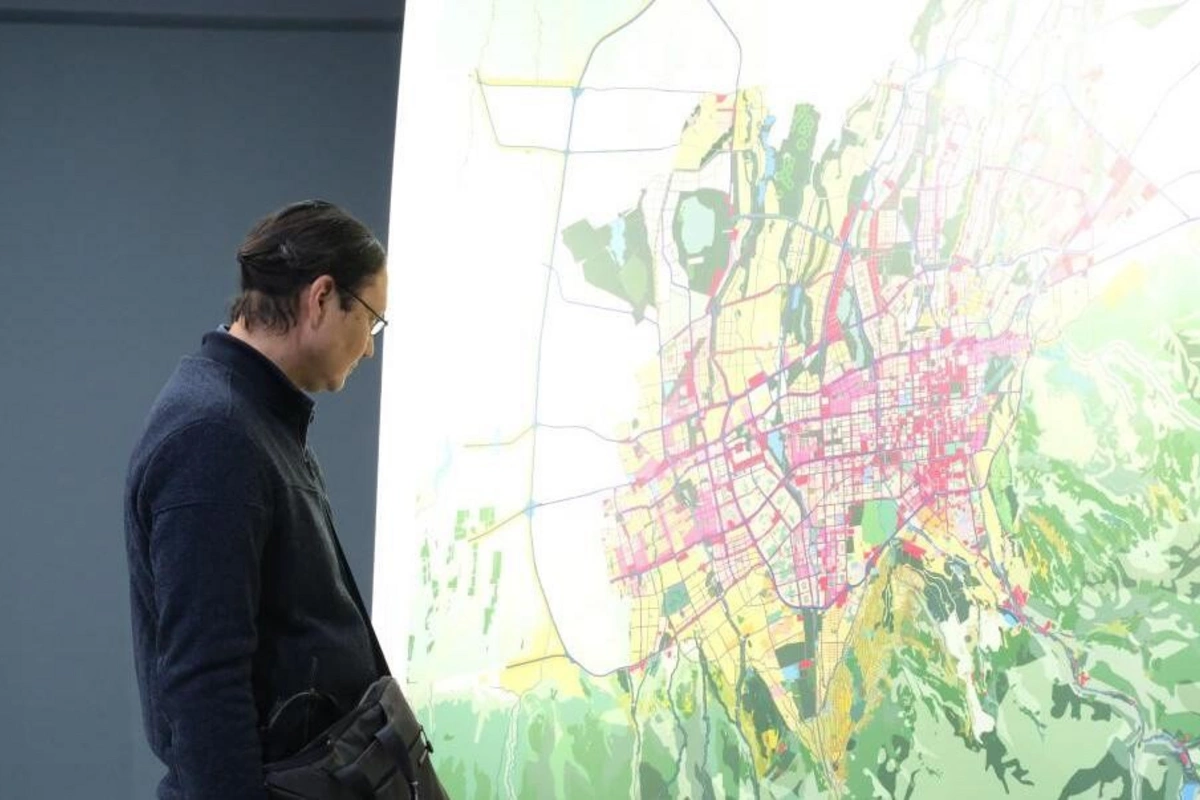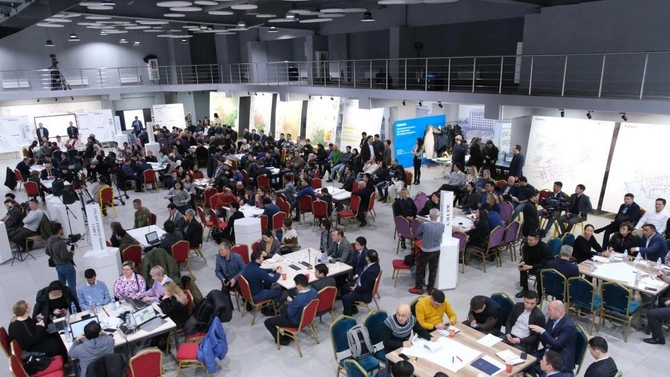
By 2040, the city's metro network is to be radically expanded and an 80-kilometer-long light rail transport network should be built.
Image: dknews.kz
(Eurasianet) The future of Kazakhstan’s largest city looks bright for pedestrians. That is just as well, because Almaty is going to have many more of them in the decades to come.
Motorists, on the other hand, are priming themselves to grumble. Which is unfortunate, as there will probably be a lot more of them too.
That is the takeaway from the urban development strategy approved by Almaty’s city council in April. The plan sets out targets and forecasts through to 2040.
The broad thrust of the blueprint is sparking some optimism in a city that has increasingly come to be associated with downtown traffic jams, pollution and unbridled construction.
“Our city should be, first of all, comfortable and safe for everyone: mothers with strollers, pedestrians, cyclists, and disabled people,” Almaty resident Vladimir Tsoi told Eurasianet. “And something needs to be done about the environment.”
The recipe for improving livability rests on a few radical proposals.
Many more pedestrian and leafy areas, the adding of 32 kilometers of routes to the existing 13 kilometers of metro lines, and the construction of an 80-kilometer-long light rail transport network. An intensive campaign of roadbuilding is intended to allow for a freer-flowing movement of buses and private cars.
The only question is whether all this will be enough to meet demand.
Almaty’s population has grown fast in the past few decades and the trend looks poised to accelerate.
The city council-approved master plan envisions the construction of more than 45 million square meters of residential space through to 2040. Even allowing for average residential space of 30 square meters per person – which is considerably higher than the current average in Kazakhstan of 23.2 square meters person – that implies building homes for 1.5 million people. In many instances, this will be a case of people moving into new apartments, but the likelihood is that population growth will be an important factor too. Almaty’s current population is a little over 2 million.
For now, champions of the pedestrian cause are cautiously cheering.
Until around a decade ago, Almaty was no place for people on foot. Many sidewalks were broken and difficult to negotiate, especially for the elderly and parents with strollers. Often sidewalks were absent altogether. Traffic lights were inconveniently spaced. Cyclists negotiating the roads, meanwhile, were taking their life into their hands.
What many see as the model to emulate is what happened with Almaty’s Panfilov Alley in 2017. The once shabby side road was reconstructed and turned into a popular walking area now frequented by families and young people alike.

Image: gov.kz
These days, there are ever more dedicated lanes for buses, as well as paths for cyclists. That has meant taking up room formerly reserved for motorists, who now seethe at routinely getting stuck in single lanes.
“It has become impossible to drive around the city, and now even on weekends you often get stuck in traffic,” Azamat Zhumanov, an Almaty resident, who drives to work in his private car, told Eurasianet. “Instead of fighting traffic jams, our authorities are doing everything to cause even more of them.”
But Roman Barabanov, a public transportation expert at Urban Forum Kazakhstan, contends that the era of the car dominating Almaty has run its course and that more emphasis should now be placed on mass transit.
“A car, as compared to a bus, can only carry a few people and takes up a lot of space on the road,” he told Eurasianet.
Barabanov is accordingly enthused by talk of the appearance of a light rail transport, or LRT, network. The idea is for the LRT to connect the center of Almaty with the densely populated areas on the fringes of the city.
Almaty used to have a tram network. The familiar yellow carriages lent a particular charm to the city well into the post-independence period and so there was considerable dismay when the mayor’s office elected in 2015 to liquidate a system that had come into being in 1937. That decision was adopted after it was determined that the tracks and rolling stock of carriages had deteriorated beyond the point of repair.
Critics of the move were incensed, arguing that city hall had simply caved to the demands of motorists wanting more lanes in which to drive.
The appearance of the LRT is intended to remedy that development.
“The tramway will return,” Barabanov said, barely disguising his joy. “Of course, this will be a completely different and more modern mode of transport.”
While the coming road and transportation fixes engender positive reactions, the prospect of massive amounts of new building is causing alarm.
In addition to all the apartment blocks, the master plan envisions the construction of around 300 kindergartens, 200 schools, 30 sports and recreation centers, dozens of clinics and three hospitals.
While these social utilities are welcome, some wonder if the scale of the proposed construction boom is entirely justified.
“It is a lot, and we do not have any data on what basis these excess figures [of new buildings] was calculated,” Asset Nauryzbayev, an economist and a contributor to the city council’s generally low-key master plan consultation process, told Eurasianet. “I assume this did not happen without a construction sector lobbyist being involved.”
Nauryzbayev warns that a season of uncontrolled construction in Almaty could turn the city into a “concrete jungle.”
There is another issue to consider here: the air.
Saltanat Tashimova, an Almaty-based artist and environmental activist known for her protests against perceived excess urban density, is one of a growing community of people who point to how haphazard development and the appearance of countless high-rise blocks has disrupted the city’s natural ventilation system. The passage of air that once carried away noxious fumes is now blocked, activist like Tashimova argue.
“The new master plan exacerbates existing problems – we need to reduce building density,” Tashimova told Eurasianet.
If city hall declines to contend with the constituency of citizens concerned about quality-of-life issues, they may find they will have a political headache to deal with down the road.
A few years ago, Tashimova and other eco-activists created the Defend Almaty movement in a collective fight against overcrowding and the cutting down of trees. They have with their regular protests become something of a thorn in the side of local officials and construction companies.
Last June, Tashimova was jailed for 15 days for holding one of her unapproved rallies. The time behind bars has not cooled her enthusiasm.
“When officials pursue their own interests, and not the interests of the citizens they are supposed to serve, protests should remind them of their duty,” Tashimova said.
Share on social media